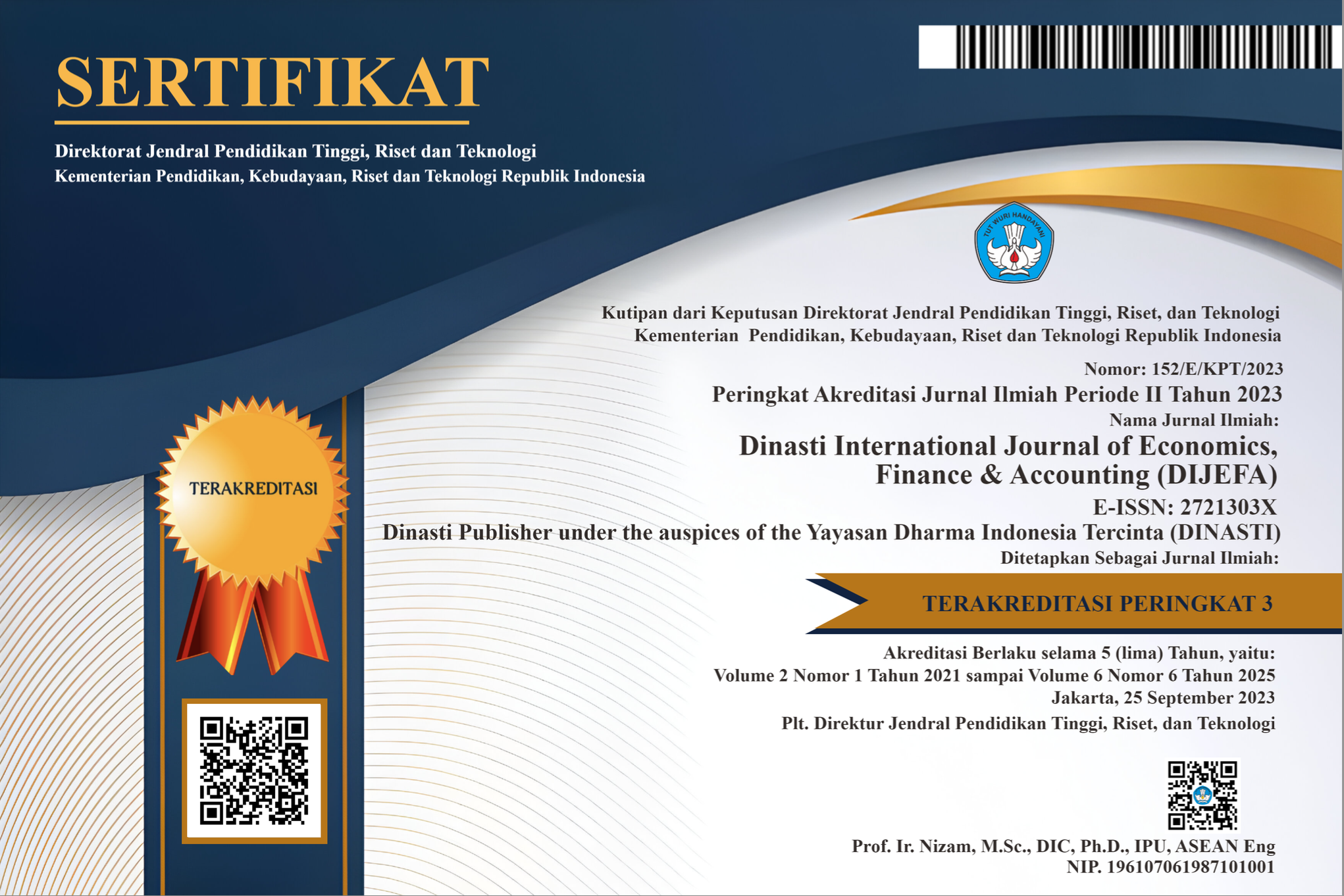Continuance Use Intention in the use of E-wallets by using the Expectation Confirmation Model through E-Satisfaction
DOI:
https://doi.org/10.38035/dijefa.v5i5.3523Keywords:
Confirmation, Perceived Usefulness, Perceived Sequrity, Satisfaction, Continuance Use IntentionAbstract
This study aims to test the use of e-wallets against continuance use intention by using expectation confirmation. This research Model uses a type of quantitative approach with the method of explanation (explanatory research). The population in this study is an e-wallet application users in Surakarta , this study uses non probability sampling method and to determine the sample using convinence sampling technique, obtained a sample of 100 respondents. The method of data analysis in this study used the technique of Structural Equation Modeling-Partial Least Square (SEM PLS). The test results showed that confirmation, and and perceived sequence had no effect on the continuity of use intention; perceived usefulness and satisfaction had no effect on the continuity of use intention, confirmation, and perceived usefulness had no effect on satisfaction; perceived sequence affects satisfaction, while satisfaction variable is stated to be able to mediate the relationship of perceived usefulness to continuance use intention mediated by satisfaction. While the relationship of confirmation variables, and perceived sequence to continuance use intention is not able to be mediated by satisfaction variables
References
Andrew, R., & Ardianti, R. (2022). Perceived playfulness, perceived usefulness, confirmation dan continuance intention pada layanan video on demand: satisfaction sebagai mediasi. MBR (Management and Business Review), 6(2), 195-211.
Bhattacherjee, A. (2001). Understanding Information Sustems Continuance : An Expectation-Confirmation Model. MIS Quarterly, 25(3), 351-370. doi : http://dx.doi.org/10.2307/3250921
Catherine, C., & Tjokrosaputro, M. (2023). Pengaruh perceived usefulness dan confirmation terhadap continuance intention pembelian tiket maskapai LCC: dengan satisfaction sebagai mediator. Jurnal Manajerial Dan Kewirausahaan, 5(2), 383-391.
Damanik, M. A. A., Fauzi, A., & Situmorang, S. H. (2022). Pengaruh Perceived Usefulness, Perceived Enjoyment dan Kepercayaan Terhadap Continuance Intention Melalui Kepuasan Pada Generasi Millenial Pengguna E-Wallet di Kota Medan. Ekonomi, Keuangan, Investasi Dan Syariah (EKUITAS), 3(4), 827-834.
Dhia, A. W. (2021). Analisis Faktor-Faktor Yang Memengaruhi Niat Melanjutkan Penggunaan E-Wallet.
Fauziah, S. A., & Ashfiasari, S. (2021). Pengaruh Social Influence dan Self-efficacy Terhadap Intention to Use Mobile Payment System Pada Pengguna E-wallet. Jurnal Ekonomi, Manajemen, Bisnis, Dan Sosial (Embiss), 1(4), 307-317.
Fazal-e-Hasan, S. M., Ahmadi, H., Mortimer, G., Grimmer, M., & Kelly, L. (2018). Examining the role of consumer hope in explaining the impact of perceived brand value on customer–brand relationship outcomes in an online retailing environment. Journal of Retailing and Consumer Services, 41, 101-111.
Foroughi, B., Iranmanesh, M., & SS, Hyun. (2019). Understanding the determinants of mobile banking continuance usage intention. Journal of Enterprise Information Management. doi : http://dx.doi.org/10.1108/JEIM-10-2018-0237
Ghozali, I. (2011). Aplikasi Analisis Multivariate dengan Program IBM SPSS 20. Semarang: Badan Penerbit Universitas Diponegoro.
Ghozali, I., & Chariri, A. (2007). Teori akuntansi. Semarang: Badan Penerbit Universitas Diponegoro.
Hasanah, U. (2020). Analisis continuance use intention pada situs jejaring sosial instagram dengan menggunakan Expectation-Confirmation Model (ECM) (Bachelor's thesis, Fakultas Sains dan Teknologi Universitas Islam Negeri Syarif Hidayatullah Jakarta).
Hsu, M.H., & Chiu, C.M. (2004). Predicting Electronic Service Continuance with A Decomposed. Behaviour & Information Technology, 23(5), 359-373. doi : https://doi.org/10.1080/01449290410001669969
Jiaxin, Z., Yan, L., & Yao, S. (2019). The Role of Consumers Perceived Security, Perceived Control, Interface Design Features, and Conscientiousness in Continuous Use of Mobile Payment Service. Sustainability, 11(23), 1-16. doi : http://dx.doi.org/10.3390/su11236843
Karim, M. W., Chowdhury, M. A. M., & Haque, A. A. (2022). A Study of Customer Satisfaction Towards E-Wallet Payment System in Bangladesh. American Journal of Economics and Business Innovation, 1(1), 1-10.
Kumar, A., Adlakaha, A., & Mukherjee, K. (2018). The effect of perceived security and grievance redressal on continuance intention to use M-wallets in a developing country. International Journal of Bank Marketing. doi : https://doi.org/10.1108/IJBM-04-2017-0077.
Maharani, B. H., Pratama, B. C., Fitriati, A., & Azizah, S. N. (2023). Continuance Intention Use E-Filing: The Influence Quality Information, System, Service and Satisfaction as a Mediator. Jurnal Proaksi, 10(4), 681-697.
Nguyen, DD dkk. (2021). Impacts of Perceived Security and Knowledge on Continuous Intention to Use Mobile Fintech Payment Services : An Empirical Study in Vietnam. Journal of Asian Finance, Economics and Business, 8(8), 287-296.
Ravishankar, B., & Christopher, P. B. (2020). Impact of innovative services on customer satisfaction and enhancing tourism: Airline and hotel services from a tourist perspective. Journal of Critical Reviews, 7(11), 705-711.
Shang, Dawei & Wu, Weiwei. (2017). Understanding mobile shopping consumers’ continuance intention. Industrial Management & Data Systems, 117(1), 213-227. doi : http://dx.doi.org/10.1108/IMDS-02-2016-0052
Susanto, A., Younghoon, C., & Youngwook, H. (2016). Determinants of continuance intention to use the smartphone banking service. Industrial Management & Data Systems, 116(3), 508-525. doi : https://doi.org/10.1108/IMDS-05-2015-0195
Tamaro., Sugiono, A., Adistya, D., & Wulandari, J. (2021). Pengaruh User Interface, Perceived Security dan Perceived Privacy terhadap E-satisfaction Menggunakan Aplikasi Traveloka. Journal of Technopreneurship on Economics and Business Review, 2(2), 60-74.
Thakur, R. (2018). The role of self-efficacy and customer satisfaction in driving loyalty to the mobile shopping application. International Journal of Retail & Distribution Management, 46(3), 283-303. doi : http://dx.doi.org/10.1177/1094670512473200 Shopback. 2021. “Shopback Insight: Survei Perilaku Pengguna E-Commerce Q1 2021”.
Tiana, T., Sugiharto, B., & Umiyati, I. (2019). ANALYSIS OF SYSTEM QUALITY, INFORMATION QUALITY AND PERCEIVED USEFULNESS TO USER SATISFACTION. JASS (Journal of Accounting for Sustainable Society), 1(01), 62-62.
Tyas, R. W., & Azizah, N. (2022). Analisa Kepuasan Pengguna Dompet Digital DANA Melalui Continuance Use Intention Dengan Expectation Confirmation Model. Jurnal Ilmiah Poli Bisnis, 126-140.
Yan, M., Filieri, R., & Gorton, M. (2021). Continuance intention of online technologies: A systematic literature review. International Journal of Information Management, 58, 102315.
Downloads
Published
How to Cite
Issue
Section
License
Copyright (c) 2024 Muhamad Khoirul Umam, Dewita Puspawati

This work is licensed under a Creative Commons Attribution 4.0 International License.
Authors who publish their manuscripts in this journal agree to the following conditions:
- The copyright on each article belongs to the author(s).
- The author acknowledges that the Dinasti International Journal of Economics, Finance & Accounting (DIJEFA) has the right to be the first to publish with a Creative Commons Attribution 4.0 International license (Attribution 4.0 International (CC BY 4.0).
- Authors can submit articles separately, arrange for the non-exclusive distribution of manuscripts that have been published in this journal into other versions (e.g., sent to the author's institutional repository, publication into books, etc.), by acknowledging that the manuscript has been published for the first time in the Dinasti International Journal of Economics, Finance & Accounting (DIJEFA).


























































